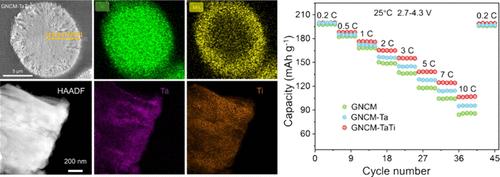Ta/Ti Codoped Concentration Gradient High-Ni Cathodes for Long-Life Li-Ion Batteries
IF 3.9
3区 工程技术
Q2 ENGINEERING, CHEMICAL
引用次数: 0
Abstract
Full concentration gradient nickel-rich ternary materials (GNCM) demonstrate cost-effectiveness and higher discharge capacity as lithium-ion battery (LIB) cathodes. However, unsatisfactory rate performances of GNCM are recognized as a limitation caused by concentration gradient elimination and surface Mn enrichment during the calcination process. To address this issue, a Ta/Ti codoping approach is developed, showing that Ta5+ can upgrade the surface of the primary particle to mitigate element diffusion at the grain boundaries, and meanwhile, Ti4+ can stabilize Ni–O to weaken Ni2+ migration. Such impacts on GNCM bring in significant advantages in terms of structure and performance to prevent irreversible phase transitions from the layered to the rock-salt structure and accelerate the diffusion kinetics of Li+ and electrons with increased electric conductivity. Consequently, the Ta/Ti codoped GNCM (labeled as GNCM-TaTi) delivered a high reversible capacity of 210.9 mAh/g at an initial rate of 0.1C and maintained 106.8 mAh/g even at a high rate of 10C. The capacity retentions can remain 98.2 and 94.7% after 100 cycles at 0.5 and 3C, respectively. Further evaluations of GNCM-TaTi in a pouch cell show a capacity retention of 90.3% at 3C after 500 cycles. The presented Ta/Ti codoping validates an effective route to strengthen the LIB performance of the high-Ni NCM with a full concentration gradient structure.

用于长寿命锂离子电池的 Ta/Ti 共掺浓度梯度高镍阴极
全浓度梯度富镍三元材料(GNCM)作为锂离子电池(LIB)正极具有成本效益和更高的放电容量。然而,由于煅烧过程中浓度梯度的消除和表面锰的富集,GNCM 的速率性能不尽如人意。为解决这一问题,我们开发了一种 Ta/Ti 共掺方法,结果表明,Ta5+ 可以提升原生粒子的表面,从而减轻元素在晶界的扩散;同时,Ti4+ 可以稳定 Ni-O 以减弱 Ni2+ 的迁移。这些对 GNCM 的影响在结构和性能方面带来了显著优势,可防止从层状结构到岩盐结构的不可逆相变,并加速 Li+ 和电子的扩散动力学,同时提高电导率。因此,Ta/Ti 共掺的 GNCM(标记为 GNCM-TaTi)在 0.1C 的初始速率下可提供 210.9 mAh/g 的高可逆容量,即使在 10C 的高速率下也能保持 106.8 mAh/g。在 0.5C 和 3C 下循环 100 次后,容量保持率分别为 98.2% 和 94.7%。在袋式电池中对 GNCM-TaTi 的进一步评估显示,在 3C 下循环 500 次后,容量保持率为 90.3%。所介绍的钽/钛共掺方法验证了一种有效的途径,可增强具有全浓度梯度结构的高镍 NCM 的锂电池性能。
本文章由计算机程序翻译,如有差异,请以英文原文为准。
求助全文
约1分钟内获得全文
求助全文
来源期刊

Industrial & Engineering Chemistry Research
工程技术-工程:化工
CiteScore
7.40
自引率
7.10%
发文量
1467
审稿时长
2.8 months
期刊介绍:
ndustrial & Engineering Chemistry, with variations in title and format, has been published since 1909 by the American Chemical Society. Industrial & Engineering Chemistry Research is a weekly publication that reports industrial and academic research in the broad fields of applied chemistry and chemical engineering with special focus on fundamentals, processes, and products.
 求助内容:
求助内容: 应助结果提醒方式:
应助结果提醒方式:


